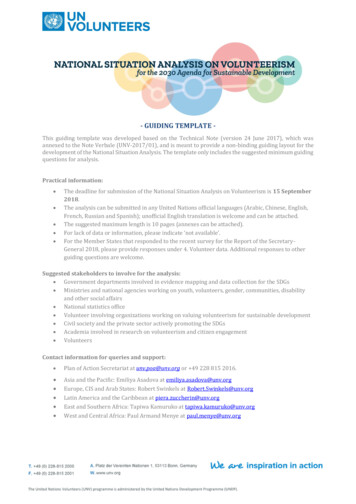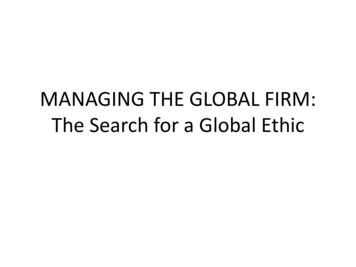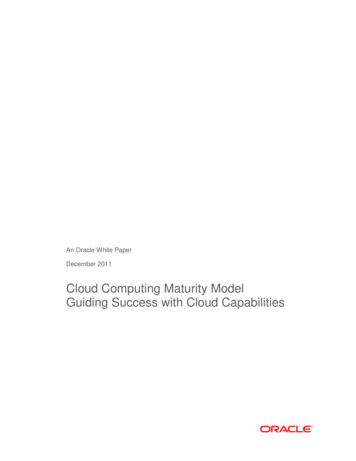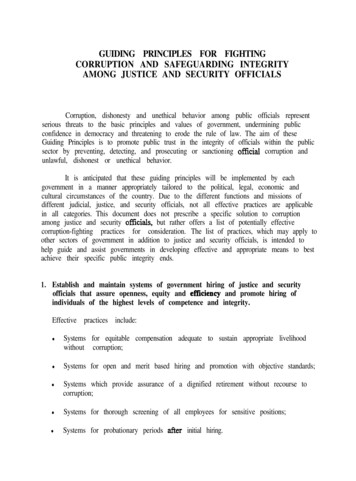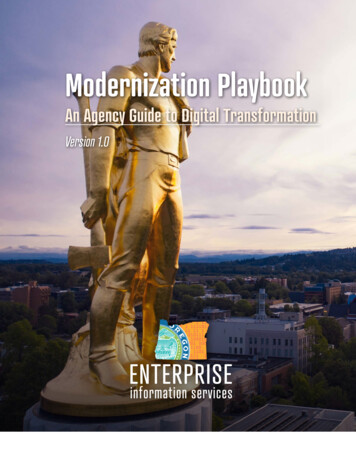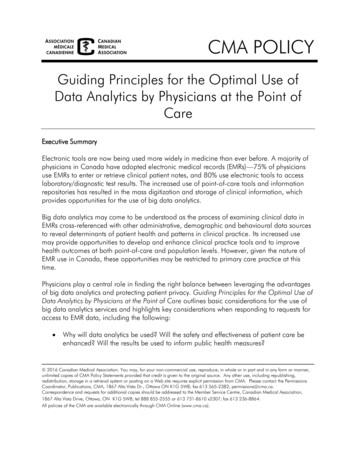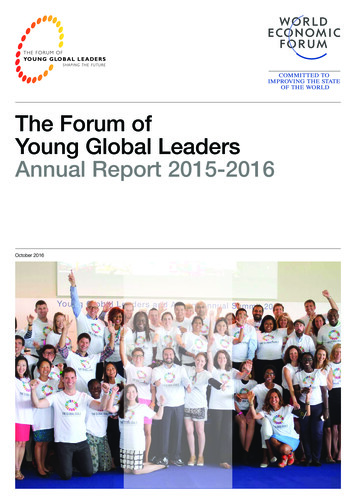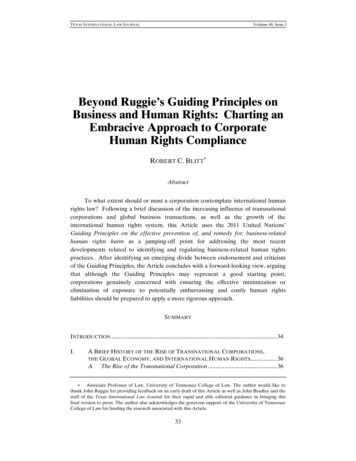
Transcription
TEXAS INTERNATIONAL LAW JOURNALVolume 48, Issue 1Beyond Ruggie’s Guiding Principles onBusiness and Human Rights: Charting anEmbracive Approach to CorporateHuman Rights ComplianceROBERT C. BLITT AbstractTo what extent should or must a corporation contemplate international humanrights law? Following a brief discussion of the increasing influence of transnationalcorporations and global business transactions, as well as the growth of theinternational human rights system, this Article uses the 2011 United Nations’Guiding Principles on the effective prevention of, and remedy for, business-relatedhuman rights harm as a jumping-off point for addressing the most recentdevelopments related to identifying and regulating business-related human rightspractices. After identifying an emerging divide between endorsement and criticismof the Guiding Principles, the Article concludes with a forward-looking view, arguingthat although the Guiding Principles may represent a good starting point,corporations genuinely concerned with ensuring the effective minimization orelimination of exposure to potentially embarrassing and costly human rightsliabilities should be prepared to apply a more rigorous approach.SUMMARYINTRODUCTION . 34I.A BRIEF HISTORY OF THE RISE OF TRANSNATIONAL CORPORATIONS,THE GLOBAL ECONOMY, AND INTERNATIONAL HUMAN RIGHTS . 36A. The Rise of the Transnational Corporation . 36 Associate Professor of Law, University of Tennessee College of Law. The author would like tothank John Ruggie for providing feedback on an early draft of this Article as well as John Bradley and thestaff of the Texas International Law Journal for their rapid and able editorial guidance in bringing thisfinal version to press. The author also acknowledges the generous support of the University of TennesseeCollege of Law for funding the research associated with this Article.33
TEXAS INTERNATIONAL LAW JOURNAL34TEXAS INTERNATIONAL LAW JOURNALB.II.Volume 48, Issue 1[VOL. 48:33International Human Rights Law: From Humble, Non-bindingBeginnings . 38CORPORATIONS AND HUMAN RIGHTS LIABILITY—A WORK INPROGRESS . 42A. Overview . 42B. The 2011 Guiding Principles on Business and Human Rights:Implementing the United Nations “Protect, Respect and Remedy”Framework. 431. Key Parameters. 432. Guiding Principles for Respecting Human Rights . 473. Guiding Principles for Responding to Negative Human RightsImpacts. 484. “Issue of Context” . 49C. Life After Ruggie’s Guiding Principles: Endorsement and Critique . 501. Endorsement . 502. Critique . 52CONCLUSION: NAVIGATING A POST-GUIDING PRINCIPLES WORLD . 56INTRODUCTIONYour corporation, Minerals R Us, is confronted with public protests andlawsuits in various countries around the world five years into an otherwise profitablemerger with Lior Minerals Inc., a company headquartered in Gisserville, the capitalof Lioria.1 While Minerals R Us is now the primary supplier of iMineral, a keycomponent necessary for powering all forms of modern gadgetry, it appears that LiorMinerals Inc. managed to extract the coveted iMineral—a complex and dangerousprocess—only after displacing an indigenous tribe and employing children based onracial preference, all the while preventing unionization through threats and theimposition of onerous contractual terms that essentially relegated employees toforced laborers.At the time of the merger, no one thought to scrutinize whether Lior Minerals’business practices violated human rights. Likewise, the cigar-chomping CEO ofMinerals R Us, Richard McKnight, never bothered to travel to Lioria to viewemployee conditions firsthand because the country consistently ranked near the topof the Failed States Index and was notorious for its widespread violence, whichparticularly targeted foreigners. During discussions leading up to the merger,McKnight was heard to remark—to affirmative nods from the board of directors—“Mine baby, mine!” and “Who gives a rat’s ass how it gets done. Just do it.”1. The names, places, and minerals referenced here are purely hypothetical and intended only for thesake of example.
TEXAS INTERNATIONAL LAW JOURNAL2012]BEYOND RUGGIE’S GUIDING PRINCIPLESVolume 48, Issue 135While this scenario may be illustrative of past standard operating procedures formany corporations, and arguably may persist in some boardrooms today, thetakeaway message intended from this Article cautions counsel against ignoringhuman rights liabilities at their own, their principals’, and indeed even theircorporation’s peril. This advice is premised on the dynamic and increasingly sociallyconscious global arena within which businesses operate, and more specifically, on theemerging international framework intended to address business-related human rightsharms. Following a brief discussion of the increasing influence of transnationalcorporations (TNCs)2 and global business transactions, as well as the growth of theinternational human rights system, this Article will discuss the most recentdevelopments related to identifying and regulating business-related human rightspractices. The departure point for this analysis will be the March 2011 GuidingPrinciples on Business and Human Rights,3 the culmination of John Ruggie’s six-yeareffort as the Special Representative of the United Nations Secretary-General(SRSG) on the issue of human rights and transnational corporations and otherbusiness enterprises.4This report, while heralded as a milestone, is only a departure point for thesimple reason that it underestimates the rapidity in which the human rightsenvironment for businesses is unfolding. Human rights advocates have alreadyexpressed concern that the SRSG’s Guiding Principles do not go far enough.5 In fact,the principles set a minimal-expectation bar for businesses, promulgating a series ofnon-binding “lowest common denominator” recommendations that arguably neglecta more complex reality.6 Based on a consideration of the emerging divide betweenendorsement and criticism of the Guiding Principles, I conclude with a forwardlooking view, arguing that although the principles may represent a good startingpoint, corporations genuinely concerned with ensuring the effective minimization orelimination of exposure to potentially embarrassing and costly human rightsliabilities should be prepared to apply a more rigorous approach.2. For the purposes of this Article, I use the terms TNC and multinational corporation (MNC)interchangeably. See Peter F. Drucker, The Global Economy and the Nation-State, 76 FOREIGN AFF. 159,167–68 (1997) (noting that more multinational corporations are becoming transnational in nature).3. Special Representative of the Secretary-General on the Issue of Human Rights and TransnationalCorporations and Other Business Enterprises, Guiding Principles on Business and Human Rights:Implementing the United Nations “Protect, Respect and Remedy” Framework, U.N. Doc. A/HRC/17/31(Mar. 21, 2011) (by John Ruggie) [hereinafter Guiding Principles].4. Shortly after his mandate as Special Representative ended, Mr. Ruggie accepted a Senior Advisorposition with Foley Hoag LLP’s Corporate Social Responsibility (CSR) practice. See John G. Ruggie,FOLEY HOAG LLP, -John.aspx (last visited Dec. 10,2012) (describing Ruggie’s position at Foley Hoag LLP).5. See, e.g., UN Human Rights Council: Weak Stance on Business Standards, H UM . RTS . W ATCH(June 16, 2011), hts-council-weak-stance-businessstandards (stating that various organizations have expressed concern that Ruggie’s Guiding Principles areweaker than established human rights norms).6. See David Bilchitz, The Ruggie Framework: An Adequate Rubric for Corporate Human RightsObligations?, 12 SUR I NT’ L J. H UM . R TS . 199, 216 (2010), available at 2.php?artigo 12,artigo 10.htm (explaining that, in an effort to find consensus,Ruggie undermined basic human rights standards by failing to state that corporations are bound to thesestandards under international law).
TEXAS INTERNATIONAL LAW JOURNAL36TEXAS INTERNATIONAL LAW JOURNALVolume 48, Issue 1[VOL. 48:33I. A BRIEF HISTORY OF THE RISE OF TRANSNATIONALCORPORATIONS, THE GLOBAL ECONOMY, AND INTERNATIONALHUMAN RIGHTSA. The Rise of the Transnational CorporationWhile the origins of the modern-day TNC can be traced back to the East IndiaCompany7 or even to ancient Rome,8 it was not until the turn of the 20th Centurythat an increasingly large number of enterprises began developing a transnationalstructure. This pattern continued through the era leading up to the Second WorldWar, and in the period that followed expanded at an unprecedented pace, fueled bycommunication and transportation advances and associated cost savings broughtabout by “containerized freight, airborne deliveries and the telex.”9In the 1960s, MNCs came to be regarded “as more progressive, dynamic, [and]geared to the future than provincial companies which avoid foreign frontiers andtheir attendant risks and opportunities.”10 Indeed, this period represented ahistorical “high-water mark in the spread of the transnational networks of UnitedStates-based industrial enterprises,” with foreign affiliates reaching an all-time high.11By the early 1990s, virtually all industrialized countries provided a base for numerousMNCs, which were fast becoming “the dominant form of organization responsiblefor the international exchange of goods and services.”12 Likewise, the pace and scaleof mergers also began growing exponentially during this period.13In the wake of this extraordinary pattern of growth and globalization, TNCsfound themselves in the startling position of outperforming the national economiesof states14—a dramatic turn of events considering that hitherto nation-states had beenconsidered the primary, if not exclusive, actors within the international order.15 Tobe certain, the nation-state’s iron-fisted grip on sovereignty has been challenged fromother directions,16 but the global rise of TNCs is unique insofar as the value-added7. NICK ROBINS, THE CORPORATION THAT CHANGED THE WORLD: HOW THE EAST INDIACOMPANY SHAPED THE MODERN MULTINATIONAL x–xii (2006).8. STANLEY BING, ROME, INC.: THE RISE AND FALL OF THE FIRST MULTINATIONAL CORPORATIONxv (2006).9. Raymond Vernon, Transnational Corporations: Where are They Coming From, Where are TheyHeaded?, 1 TRANSNAT’L CORPS. 7, 10 (1992).10. Howard V. Perlmutter, The Tortuous Evolution of the Multinational Corporation, COLUM. J.WORLD BUS., Jan-Feb 1969, at 9, 10.11. Vernon, supra note 9, at 12.12. Id. at 7.13. Id. at 20.14. Consider Apple Inc.’s 76 billion pile of cash, which in mid-2011 outstripped U.S. cash reserves.Matt Hartley, U.S. Balance Now Less Than Apple Cash, FIN. POST (July 28, 2011, 4:56 -s-balance-now-less-than-apple-cash/.15. The Charter of the United Nations reaffirms this traditional view by restricting its membershipexclusively to “other peace-loving states.” U.N. Charter art. 4, para. 1. The modern state system typicallydates to the Treaty of Westphalia in 1648. Daud Hassan, The Rise of the Territorial State and The Treatyof Westphalia, 9 Y.B. N.Z. JURIS. 62, 69 (2006).16. See Robert Charles Blitt, Who Will Watch the Watchdogs? Human Rights NongovernmentalOrganizations and the Case for Regulation, 10 BUFF. HUM. RTS. L. REV. 261, 304 n.192 (2004) (offeringexamples of non-governmental organizations making critical statements that have posed a challenge to thesovereignty of some nation-states, such as Sudan, in the past).
TEXAS INTERNATIONAL LAW JOURNAL2012]Volume 48, Issue 1BEYOND RUGGIE’S GUIDING PRINCIPLES37activities of the 100 largest corporations have grown faster than those of nationstates, indicating their critical importance in the global economy.17 As if tounderscore the point, studies estimate that TNCs today make up one-third to onehalf of the world’s 100 largest economic entities.18 In the face of this economic might,it seems reasonable that Howard V. Perlmutter, writing in the 1960s, called “thesenior executives engaged in building the geocentric enterprise . . . the mostimportant social architects of the last third of the twentieth century. For theinstitution they are trying to erect promises a greater universal sharing of wealth anda consequent control of the explosive centrifugal tendencies of our evolving worldcommunity.”19Despite its 1960s sanguinity—and putting aside that the phrase “geocentricenterprise” conjures up a discarded script from Mad Men (CEO of Minerals R Us:“We need some creative ideas for cleaning up our shabby corporate image.” SterlingCooper Copywriter: “How does ‘geocentric enterprise’ grab you?”)—Perlmutter’svision evidences that even early in their modern development, TNCs, for better orworse, exhibited a powerful potential capable of displacing the ability of governmentto exert influence over their actions.20 If anything, the last fifty years have made itclear that states no longer hold a monopoly on manipulating the internationalsystem, and moreover, that corporate and state interests are not necessarily alwayssimpatico.21 Indeed, much like states, many TNCs today “have the resources andpower both to perpetrate and to escape responsibility” for human rights abuses.22Partly because of this unfolding new reality, a parallel rising emphasis ongreater accountability now confronts these corporate actors. As writer CharlesHandy has observed:If we haven’t bothered much about these things in the past, it is probablybecause we never thought of businesses as political institutions, but ratheras engines and instruments of commerce, as machines not communities.We did not, therefore, apply the same rules to them as we would to a17. Press Release, U.N. Conference on Trade and Development, Are Transnationals Bigger thanCountries?, U.N. Press Release TAD/INF/PR/47 (Aug. 12, 2002) [hereinafter UNCTAD Press Release];see also SARAH ANDERSON & JOHN CAVANAGH, INSTITUTE FOR POLICY STUDIES, TOP 200: THE RISEOF CORPORATE GLOBAL POWER i (2000) (“The Top 200 corporations’ sales are growing at a faster ratethan overall global economic activity. Between 1983 and 1999, their combined sales grew from theequivalent of 25.0 percent to 27.5 percent of World GDP.”).18. UNCTAD Press Release, supra note 17.19. Perlmutter, supra note 10, at 18. According to Perlmutter, the geocentric enterprise offered “aninstitutional and supra-national framework which could conceivably make war less likely, on theassumption that bombing customers, suppliers and employees is in nobody’s interest.” Id.20. Vernon, supra note 9, at 27.21. Whereas the bottom line for many TNCs is maximizing share price, nation-states ideally seek toimprove material welfare as a whole while keeping the peace. See Celia Wells & Juanita Elias, Catchingthe Conscience of the King: Corporate Players on the International Stage, in NON-STATE ACTORS ANDHUMAN RIGHTS 141, 145–50 (Philip Alston ed., 2005) (comparing the traditional role of international lawin a “state-centric” system, where the motivation is the protection of citizens, to the altered role ofinternational law where the state sovereignty is challenged by MNCs interested in low production costseffectuated by minimal human rights standards).22. Id. at 142; see also Claudio Grossman & Daniel D. Bradlow, Are We Being Propelled Towards APeople-Centered Transnational Legal Order?, 9 AM. U. J. INT’L L. & POL’Y 1, 8 (1993) (“The fact that theyhave multiple production facilities means that TNCs can evade state power and the constraints of nationalregulatory schemes.”).
TEXAS INTERNATIONAL LAW JOURNAL38TEXAS INTERNATIONAL LAW JOURNALVolume 48, Issue 1[VOL. 48:33nation-state, where matters of human rights, free speech and theresponsibility of governors to the governed would be argued about andeven fought over.23B. International Human Rights Law: From Humble, Non-binding BeginningsThe 1948 Universal Declaration of Human Rights (UDHR) is often credited asthe first modern acknowledgment on the part of states that international law can infact serve as a source of rights and responsibilities for individual as well as stateactors.24 While the United Nations (U.N.) General Assembly voted unanimously toendorse the UDHR, it did so with the express understanding that its contentconstituted an aspirational statement of human rights principles, rather than abinding treaty capable of establishing legally enforceable obligations on the part ofstates.25 In the words of Eleanor Roosevelt, chairperson of the internationalcommission responsible for drafting the UDHR, it “was not a treaty or internationalagreement and did not impose legal obligations; it was rather a statement of basicprinciples of inalienable human rights setting up a common standard of achievementfor all peoples and all nations.”26Despite the seemingly constrained ambition of the UDHR, bindinginternational law has a funny way of being created out of the customary (distinctfrom contractual or treaty) practices of states, provided that such practices arereadily identifiable as being widespread, consistent, and motivated by a sense of legalobligation.27 And this is precisely what has transpired in the case of the rightsexpressed in the UDHR. Soon after the UDHR’s passage, the International Courtof Justice reasoned that its provisions reflected guiding principles of law and basictenets of humanity.28 By the 1970s, evolving state practice allowed the renownedinternational law scholar Ian Brownlie to acknowledge that “the indirect legal effectof the Declaration is not to be underestimated and it is frequently regarded as a partof the ‘law of the United Nations.’”29 Closer to home, the United States Court ofAppeals for the Second Circuit in 1980 observed that the prohibition against torture23. Charles Handy, The World in 1997: Will Your Company Become a Democracy?, ECONOMIST,Jan. 10, 2011, available at http://www.economist.com/node/17878558.24. Margaret R. Somers & Christopher N.J. Roberts, Toward a New Sociology of Rights: AGenealogy of “Buried Bodies” of Citizenship and Human Rights, 4 ANN. REV. L. SOC. SCI. 385, 391 (2008)(quoting JUDITH BLAU & ALBERTO MONCADA, HUMAN RIGHTS: BEYOND THE LIBERAL VISION 33(M.D. Lanham ed., 2005)) (The UDHR is “today recognized as perhaps the ‘fundamental source ofinspiration for international efforts to promote and protect human rights and fundamental freedoms, and. . . the canonical reference for all other human rights instruments.’”).25. See The Foundation of International Human Rights, UNITED NATIONS, http://www.un.org/en/documents/udhr/hr law.shtml (last visited June 24, 2012) (noting that the UDHR was originally acommitment to upholding dignity and justice that was slowly translated into law over the years).26. 1948 U.N.Y.B. 527, U.N. Sales No. 1950.I.II [hereinafter U.N.Y.B.]; History of the Document,UNITED NATIONS, http://www.un.org/en/documents/udhr/history.shtml (last visited June 24, 2012).27. See Corfu Channel Case (U.K. and N. Ir. v. Alb.), 1949 I.C.J. 4, at 22 (Apr. 9) (“Such obligationsare based, not on the Hague Convention of 1907 . . . but on certain general and well-recognized principles,namely: elementary considerations of humanity, even more exacting in peace than in war; the principle ofthe freedom of maritime communication; and every State's obligation not to allow knowingly its territoryto be used for acts contrary to the rights of other States.”).28. Id.29. IAN BROWNLIE, PRINCIPLES OF PUBLIC INTERNATIONAL LAW 559 (7th ed. 2008).
TEXAS INTERNATIONAL LAW JOURNAL2012]Volume 48, Issue 1BEYOND RUGGIE’S GUIDING PRINCIPLES39had “become part of customary international law, as evidenced and defined by the[UDHR].”30In an even broader recognition of this unfolding process, others have concludedthat many of the UDHR’s provisions “have become incorporated into customaryinternational law, which is binding on all states.”31 The U.N. itself confirmed thisevolutionary process on the occasion of the UDHR’s 60th anniversary, when itrecognized that the document’s aspirational commitment[o]ver the years . . . has been translated into law, whether in the forms oftreaties, customary international law, general principles, regionalagreements and domestic law, through which human rights are expressedand guaranteed.Indeed, the UDHR has inspired more than 80international human rights treaties and declarations, a great number ofregional human rights conventions, domestic human rights bills, andconstitutional provisions, which together constitute a comprehensivelegally binding system for the promotion and protection of human rights.32Ultimately, the UDHR was only the opening salvo in the rapid development ofa binding system of international human rights law that continues to expand andentrench itself today in international, regional, and domestic contexts. Beginningwith the lynchpin covenants governing both civil and political rights and economic,social, and cultural rights33 (together with the UDHR, sometimes referred to as theInternational Bill of Human Rights), the international community has drafted andratified a total of nine core international human rights treaties, with the mostrecent—addressing enforced disappearance—entering into force at the end of 2010.34Among other things, these regimes require state reporting on implementation andestablish committees of independent experts responsible for engaging with stateparties and providing authoritative interpretations of treaty provisions.3530. Filartiga v. Pena-Irala, 630 F.2d 876, 882 (2d Cir. 1980).31. Hurst Hannum, The UDHR In National and International Law, 3 HEALTH & HUM. RTS. 144, 145(1998).NATIONS,32. l (last visited June 21, 2012).33. International Covenant on Civil and Political Rights [ICCPR], G.A. Res. 2200A (XXI), U.N.Doc. A/6316 (Dec. 16, 1966) (entered into force Mar. 23, 1976); International Covenant on Economic,Social and Cultural Rights [ICESCR], G.A. Res. 2200A (XXI), U.N. Doc. A/6316 (Dec. 16, 1966) (enteredinto force Jan. 3, 1976).34. Human Rights Treaty Bodies, OFF. U.N. HIGH COMMISSIONER HUM. ndex.htm (last visited June 22, 2012). In addition to theInternational Convention for the Protection of All Persons from Enforced Disappearance (CPED) andthe covenants noted above (ICCPR and ICESR), the core treaties consist of the following: TheInternational Convention on the Elimination of All Forms of Racial Discrimination (ICERD) (1965); theConvention on the Elimination of All Forms of Discrimination against Women (CEDAW) (1979); theConvention Against Torture and Other Cruel, Inhuman or Degrading Treatment (CAT) (1984); theConvention on the Rights of the Child (CRC) (1989); the International Convention on the Protection ofthe Rights of All Migrant Workers and Members of Their Families (ICRMW) (1990); and the Conventionon the Rights of Persons with Disabilities (CRPD) (2006). See International Law, OFF. U.N. HIGHCOMMISSIONER HUM. RTS., http://www2.ohchr.org/english/law/index.htm (last visited June 24, 2012)(providing a list and links to the full text of the core international human rights instruments).35. Human Rights Treaty Bodies, supra note 34.
TEXAS INTERNATIONAL LAW JOURNAL40TEXAS INTERNATIONAL LAW JOURNALVolume 48, Issue 1[VOL. 48:33Even more profoundly, the European regional human rights system hasestablished a judicial mechanism empowered to hear individual complaints filedagainst state parties and issue binding judgments. Within this framework, theEuropean Court of Human Rights serves as the final “supranational” court of appealon matters relating to the European Convention for the Protection of Human Rightsand Fundamental Freedoms—a treaty premised on “tak[ing] the first steps for thecollective enforcement of certain of the rights stated in the [UDHR].”36 Similarefforts and systems have evolved in other geographic regions including the Americasand Africa with varying degrees of success.37Finally, in the domestic context, the promise of the UDHR has informed thedrafting of national constitutions and served as a touchstone for defining humanrights protections for over half a century.38 In this regard, its influence has beenbroad and far-reaching, coloring the constitutional outcomes in a diverse array ofcountries, including New Zealand, Iraq, Afghanistan, South Africa, and all the statesof the former Soviet Union and Warsaw Pact, to name a few.39From this brief survey, it becomes evident that the powerful logic, appeal, andmoral currency of human rights continues to gain ground, permeating virtually everyaspect of our lives, from the global to the local. Human rights have served as therallying cry for “Arab Spring” protestors braving confrontation with theirgovernments in the streets,40 and violations of these rights have provided the basis forthe International Criminal Court’s indictment against the now-deceased Libyanstrongman Muammar Gaddafi.41 In a parallel development, the human rightsdiscourse—long considered applicable only to the relationship between governmentsand the governed—is increasingly being invoked as a reference point forrelationships between individuals and corporate actors. For example, the 1979Convention on the Elimination of All Forms of Discrimination against Women(CEDAW) foreshadowed this spillover effect by requiring state parties inter alia“[t]o take all appropriate measures to eliminate discrimination against women by anyperson, organization or enterprise” (emphasis added).42 To gauge how far-reachingand all-permeating this phenomenon has become, consider that all of the followinghave potential human rights implications: the coffee you drink,43 the clothing you36. European Convention for the Protection of Human Rights and Fundamental Freedoms pmbl.,opened for signature Nov. 4, 1950, E.T.S. No. 005 (entered into force Sept. 3, 1953).37. See Dinah Shelton, International Human Rights Law: Principled, Double, or Absent Standards, 25LAW & INEQ. 467, 476–79 (2007) (discussing the UDHR and subsequent human rights treaties in theAmericas); Nsongurua J. Udombana, Mission Accomplished? An Impact Assessment of the UDHR inAfrica, 30 HAMLINE J. PUB. L. & POL’Y 335, 336–38 (2008) (noting the impact of the UDHR onorganizational efforts in Africa to improve human rights and their effectiveness).38. A.E. Dick Howard, A Traveler from an Antique Land: The Modern Renaissance of ComparativeConstitutionalism, 50 VA. J. INT’L L. 3, 18 (2009).39. Robert C. Blitt, Should New Bills of Rights Address Emerging International Human RightsNorms? The Challenge of ‘Defamation of Religion,’ 9 NW. U. J. INT’L HUM. RTS. 1, 2 (2010).40. Shadi Mokhtari, The Middle East and Human Rights: Inroads Towards Charting Its Own Path, 10NW. U. J. INT'L HUM. RTS. 194, 195 (2012).41. Prosecutor v. Muammar Mohammed Abu Minyar Gaddafi, Case No. ICC-01/11, Warrant ofArrest, para. 3 (June 27, 2011), 42. Convention on the Elimination of All Forms of Discrimination against Women art. 2(e), G.A.Res. 34/180, U.N. Doc. A/RES/34/46 (Sept. 3, 1981) [hereinafter CEDAW].43. See As the Global Coffee Crisis Worsens, a Human Rights Organization Launches a GrassrootsCampaign Demanding that Folgers Start Offering Fair Trade Coffee, DEMOCRACY NOW (Dec. 24, 2001),http://www.democracynow.org/2001/12/24/as the global coffee crisis worsens (discussing the global crisis
TEXAS INTERNATIONAL LAW JOURNAL2012]BEYOND RUGGIE’S GUIDING PRINCIPLESVolume 48, Issue 141wear,44 your Internet search results,45 the computer you buy,46 and the diamondsencrusting the whip Lady Gaga reportedly presented Beyoncé for her 29th birthday.47Thus, the story of the UDHR is the story of how aspirational non-bindingprinciples, or “soft law,” can evolve continually over time into more durable andenforceable “hard law”—either in the form of a written treaty or in the consolidationof customary international practice. As I argue below, this is the most importantlesson for corporate counsel to internalize when contemplating the evolvingrelationship between business and human rights. Put simply, although SRSGRuggie’s freshly minted Guiding Principles might strike one as plainly non-bindingand aspirational today, these same principles can and will find surreptitious ways ofgrowing up and becoming enforceable international norms that may carry seriousrepercussions for corporations, officers, and ill-prepared shareholders.created by the collapse in coffee prices and human rights campaigns demanding free trade coffee); see alsoSarah Lyon, Fair Trade Coffee and Human Rights in Guatemala, 30 J. CONSUMER POL’Y 241, 242–43(2007) (arguing that “fair trade consumpti
Corporations and Other Business Enterprises, Guiding Principles on Business and Human Rights: Implementing the United Nations "Protect, Respect and Remedy" Framework, U.N. Doc. A/HRC/17/31 (Mar. 21, 2011) (by John Ruggie) [hereinafter Guiding Principles]. 4. Shortly after his mandate as Special Representative ended, Mr. Ruggie accepted a .


